Non-Potato Veggie Chips Market
Non-Potato Veggie Chips Market Size and Share Forecast Outlook 2025 to 2035
Non-potato veggie chips market is projected to grow from USD 2.1 billion in 2025 to USD 4.2 billion by 2035, at a CAGR of 7.2%. Kale/spinach will dominate with a 37.0% market share, while retail will lead the distribution channel segment with a 54.0% share.
Non-Potato Veggie Chips Market Forecast and Outlook 2025 to 2035
The non-potato vegetable chips industry stands at the threshold of a decade-long expansion trajectory that promises to reshape healthy snacking, retail food distribution, and specialty nutrition applications worldwide. The market's journey from USD 2.1 billion in 2025 to USD 4.2 billion by 2035 represents substantial growth, the market will rise at a CAGR of 7.2% which demonstrating the accelerating adoption of plant-based snack alternatives and health-conscious food processing systems across retail chains, specialty food manufacturers, and organic nutrition sectors.
The first half of the decade (2025-2030) will witness the market climbing from USD 2.1 billion to approximately USD 2.9 billion, adding USD 0.8 billion in value, which constitutes 38% of the total forecast growth period. This phase will be characterized by the rapid adoption of kale and spinach-based chip systems, driven by increasing health consciousness and the growing need for nutritious snacking alternatives worldwide. Advanced processing capabilities and flexible production systems will become standard expectations rather than premium options.
The latter half (2030-2035) will witness steady growth from USD 2.9 billion to USD 4.2 billion, representing an addition of USD 1.3 billion or 62% of the decade's expansion. This period will be defined by mass market penetration of specialized vegetable chip technologies, integration with comprehensive retail platforms, and seamless compatibility with existing food distribution infrastructure. The market trajectory signals fundamental shifts in how producers approach healthy snacking optimization and nutrition quality management, with participants positioned to benefit from constant demand across multiple vegetable types and distribution segments.
Quick Stats for Non-Potato Veggie Chips Market
- Non-Potato Veggie Chips Market Value (2025): USD 2.1 billion
- Non-Potato Veggie Chips Market Forecast Value (2035): USD 4.2 billion
- Non-Potato Veggie Chips Market Forecast CAGR: 7.2%
- Leading Vegetable Type in Non-Potato Veggie Chips Market: Kale/spinach
- Key Growth Regions in Non-Potato Veggie Chips Market: North America, Europe, and Asia Pacific
- Top Key Players in Non-Potato Veggie Chips Market: Rhythm Foods, Bare Snacks, Sensible Portions, Brad's Plant Based, Simply 7
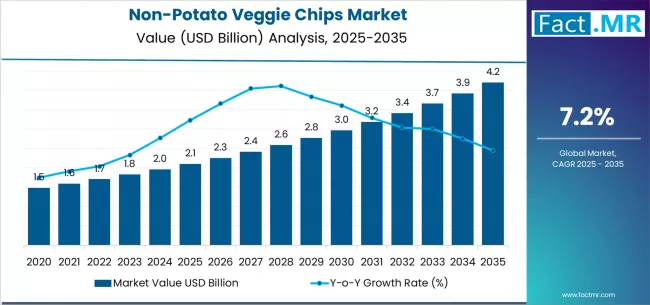
The market demonstrates distinct growth phases with varying market characteristics and competitive dynamics. Between 2025 and 2030, the market progresses through its health adoption phase, expanding from USD 2.1 billion to USD 2.9 billion with steady annual increments averaging 7.2% growth. This period showcases the transition from traditional snack alternatives to advanced kale and spinach-based systems with enhanced nutritional capabilities and integrated quality control systems becoming mainstream features.
The 2025-2030 phase adds USD 0.8 billion to market value, representing 38% of total decade expansion. Market maturation factors include standardization of retail and food manufacturing protocols, declining component costs for specialized vegetable processing equipment, and increasing industry awareness of health benefits reaching 95-98% processing effectiveness in retail and specialty food applications. Competitive landscape evolution during this period features established food companies like General Mills and PepsiCo expanding their veggie chip portfolios while specialty manufacturers focus on advanced processing development and enhanced nutritional capabilities.
From 2030 to 2035, market dynamics shift toward advanced nutrition integration and global retail expansion, with growth continuing from USD 2.9 billion to USD 4.2 billion, adding USD 1.3 billion or 62% of total expansion. This phase transition centers on specialized vegetable chip processing systems, integration with automated retail networks, and deployment across diverse commercial and household scenarios, becoming standard rather than specialized applications. The competitive environment matures with focus shifting from basic processing capability to comprehensive nutrition optimization systems and integration with supply chain monitoring platforms.
Non-Potato Veggie Chips Market Key Takeaways
At-a-Glance Metrics
| Metric | Value |
|---|---|
| Market Value (2025) → | USD 2.1 billion |
| Market Forecast (2035) ↑ | USD 4.2 billion |
| Growth Rate ★ | 7.2% CAGR |
| Leading Technology → | Kale/spinach Vegetable Type |
| Primary Application → | Retail Channel Segment |
The market demonstrates strong fundamentals with kale and spinach applications capturing a dominant share through advanced nutrition and health optimization capabilities. Retail channels drive primary demand, supported by increasing health consciousness and specialty food distribution requirements. Geographic expansion remains concentrated in developed markets with established health food infrastructure, while emerging economies show accelerating adoption rates driven by wellness industry modernization and rising nutritional standards.
Why is the Non-Potato Veggie Chips Market Growing?
Market expansion rests on three fundamental shifts driving adoption across the retail, online, and foodservice sectors. First, health consciousness demand creates compelling nutritional advantages through non-potato veggie chips that provide immediate wellness solutions without compromising taste, enabling retailers and consumers to meet dietary requirements while maintaining snacking satisfaction and reducing health concerns. Second, retail health food modernization accelerates as food distribution facilities worldwide seek advanced nutritious products that complement traditional snack offerings, enabling precise nutrition delivery and quality control that align with industry standards and health regulations.
Third, specialty food innovation drives adoption from manufacturing facilities and health food producers requiring effective nutrition solutions that minimize processed ingredients while maintaining operational productivity during production and distribution operations. However, growth faces headwinds from ingredient cost challenges that vary across suppliers regarding the sourcing of specialty vegetables and organic processing requirements, which may limit adoption in cost-sensitive environments. Technical limitations also persist regarding shelf-life stability and texture consistency that may reduce effectiveness in extended storage conditions, which affect product quality and consumer acceptance.
Opportunity Pathways - Non-Potato Veggie Chips Market
The non-potato veggie chips market represents a transformative healthy snacking opportunity driven by expanding consumer health consciousness, retail nutrition modernization, and the need for superior nutritional effectiveness in diverse food distribution applications. As retailers worldwide seek to achieve 95-98% customer satisfaction, reduce unhealthy inventory, and integrate advanced nutrition systems with retail platforms, veggie chips are evolving from niche products to sophisticated nutritional solutions ensuring consumer wellness and retail success.
The market's growth trajectory from USD 2.1 billion in 2025 to USD 4.2 billion by 2035 at a 7.2% CAGR reflects fundamental shifts in consumer dietary requirements and health food optimization. Geographic expansion opportunities are particularly pronounced in North America markets, while the dominance of kale/spinach systems (37.0% market share) and retail channels (54.0% share) provides clear strategic focus areas.
Pathway A - Kale/Spinach Leadership & Advanced Nutrition OptimizationStrengthening the dominant kale/spinach segment (37.0% market share) through enhanced processing formulations, superior nutritional content, and automated production systems. This pathway focuses on optimizing nutrient density, improving taste consistency, extending operational effectiveness to 95-98% success rates, and developing specialized varieties for diverse consumer applications. Market leadership consolidation through advanced food engineering and automated production integration enables premium positioning while defending competitive advantages against alternative vegetables. Expected revenue pool: USD 310-420 million
Pathway B - North America Retail Expansion & Distribution LocalizationRapid health food and specialty retail growth across North America creates substantial expansion opportunities through local distribution capabilities and retail partnership development. Growing wellness consciousness and government nutrition initiatives drive steady demand for advanced veggie chip systems. Localization strategies reduce distribution costs, enable faster retail support, and position companies advantageously for retail programs while accessing growing health food markets. Expected revenue pool: USD 240-325 million
Pathway C - Retail Channel Market Dominance & Quality IntegrationExpansion within the dominant retail segment (54.0% market share) through specialized products addressing consumer health standards and high-volume retail requirements. This pathway encompasses automated distribution systems, quality control integration, and compatibility with diverse retail processes. Premium positioning reflects superior nutritional performance and comprehensive retail compliance supporting modern food distribution. Expected revenue pool: USD 200-270 million
Pathway D - Online Channel Application DiversificationStrategic expansion into online channel applications (31.0% market share) requires enhanced packaging capabilities and specialized products addressing e-commerce operational requirements. This pathway addresses direct-to-consumer delivery, subscription services, and digital retail integration with advanced packaging for demanding shipping conditions. Premium pricing reflects specialized performance requirements and extended shelf-life standards. Expected revenue pool: USD 170-230 million
Pathway E - Foodservice Application InnovationDevelopment of specialized veggie chip products for foodservice applications (15.0% share), addressing specific restaurant requirements and institutional food demands. This pathway encompasses bulk packaging systems, customized formulations, and cost-effective alternatives for price-sensitive markets. Technology differentiation through foodservice-focused products enables diversified revenue streams while reducing dependency on single distribution platforms. Expected revenue pool: USD 140-190 million
Pathway F - Organic/Natural Claim Development & Health IntegrationExpansion of organic/natural segment (44.0% market share) through enhanced health properties, premium nutrition applications, and specialized wellness requirements. This pathway encompasses certified organic development, clean-label applications, and specialty health products requiring purity characteristics. Market development through advanced health engineering enables differentiated positioning while accessing wellness markets requiring organic veggie chip solutions. Expected revenue pool: USD 120-160 million
Pathway G - Environmental Compliance & Sustainable Processing DevelopmentDevelopment of environmentally superior veggie chip production addressing regulatory compliance and sustainability requirements across retail and foodservice applications. This pathway encompasses eco-friendly farming practices, eco-friendly processing methods, and comprehensive environmental documentation. Premium positioning reflects environmental leadership and regulatory expertise while enabling access to environmentally-focused retail programs and sustainability-driven partnerships. Expected revenue pool: USD 100-135 million
Segmental Analysis
Primary Classification: The market segments by vegetable type into Kale/spinach, Beetroot, and Carrot/others categories, representing the evolution from traditional potato alternatives to specialized nutritional solutions for comprehensive health optimization.
Secondary Classification: Distribution channel segmentation divides the market into Retail, Online, and Foodservice sectors, reflecting distinct requirements for nutritional performance, distribution capacity, and consumer quality standards.
Tertiary Classification: Claim segmentation covers Organic/Natural, Gluten-free, and Conventional categories, with developed markets leading adoption while emerging economies show accelerating growth patterns driven by health consciousness expansion programs.
The segmentation structure reveals nutrition progression from standard snack alternatives toward specialized health systems with enhanced nutritional and wellness capabilities, while distribution diversity spans from retail operations to specialized online and foodservice applications requiring precise nutritional solutions.
By Vegetable Type, the Kale/spinach Segment Accounts for Dominant Market Share
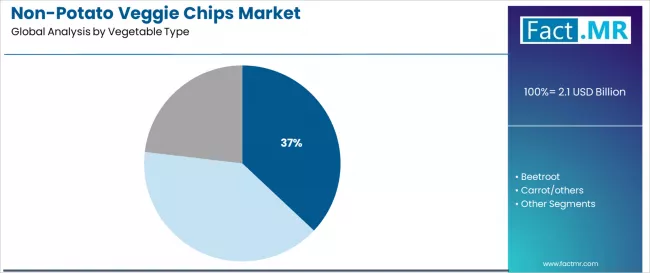
Market Position: Kale/spinach systems command the leading position in the market with approximately 37.0% market share through advanced nutritional features, including superior vitamin content, flexible processing capability, and health optimization that enable producers to achieve optimal nutritional benefits across diverse retail and consumer environments.
Value Drivers: The segment benefits from consumer preference for reliable nutrition systems that provide consistent health performance, reduced processed ingredients, and wellness optimization without requiring significant dietary modifications. Advanced nutritional features enable automated processing systems, consistency control, and integration with existing retail equipment, where nutritional performance and health reliability represent critical consumer requirements.
Competitive Advantages: Kale/spinach systems differentiate through proven nutritional stability, consistent health characteristics, and integration with automated retail systems that enhance consumer satisfaction while maintaining optimal quality suitable for diverse retail and household applications.
Key market characteristics:
- Advanced processing formulations with optimized vitamin content and nutritional capabilities
- Extended shelf effectiveness, enabling 95-98% quality success with consistent nutritional delivery
- Retail compatibility, including automated distribution systems, quality monitoring, and process integration for retail and consumer operations
Beetroot Applications Show Strong Market Growth
Beetroot chip systems maintain a significant 29.0% market share in the market due to their specialized nutritional properties and versatile taste advantages. These systems appeal to consumers requiring high-quality nutrition with unique characteristics for retail, online, and specialty applications. Market growth is driven by superfood recognition expansion, focusing reliable nutrition solutions and consumer satisfaction through optimized processing systems.
By Distribution Channel, the Retail Segment Accounts for the Largest Market Share
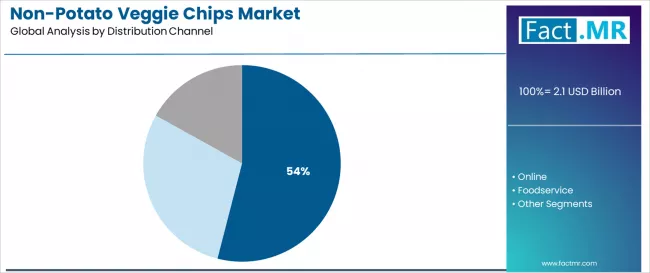
Market Context: Retail applications dominate the market with approximately 54.0% market share due to widespread adoption of health products and increasing focus on wellness merchandising, consumer accessibility, and retail management applications that minimize inventory failures while maintaining food retail industry standards.
Appeal Factors: Retail operators prioritize product reliability, nutritional consistency, and integration with existing retail infrastructure that enables coordinated health product distribution across multiple store locations. The segment benefits from substantial retail investment and modernization programs that emphasize the acquisition of health products for consumer satisfaction and operational efficiency applications.
Growth Drivers: Retail health expansion programs incorporate veggie chips as standard products for health food operations, while wellness consumer initiatives increase demand for advanced nutritional capabilities that comply with food safety standards and minimize consumer complaints.
Market Challenges: Varying retail standards and distribution technology differences may limit product standardization across different retail facilities or operational scenarios.
Application dynamics include:
- Strong growth in health food stores and major retailers requiring precise nutritional capabilities
- Increasing adoption in wellness merchandising applications for health-conscious consumers
- Rising integration with automated retail systems for inventory optimization and quality assurance
Online Channel Applications Demonstrate Steady Growth
Online channel applications capture approximately 31.0% market share through specialized distribution requirements in e-commerce platforms, direct-to-consumer sales, and subscription service applications. These channels demand robust products capable of operating in diverse shipping conditions while providing effective nutrition delivery and customer satisfaction.
Foodservice Applications Show Specialized Demand
Foodservice applications account for approximately 15.0% market share, including restaurant menu integration, institutional food services, and specialty foodservice applications requiring nutritional capabilities for meal enhancement and health offerings.
What are the Drivers, Restraints, and Key Trends of the Non-Potato Veggie Chips Market?
Growth Accelerators: Consumer health consciousness drives primary adoption as non-potato veggie chips provide nutritional benefits that enable consumers to meet wellness goals without sacrificing snacking enjoyment, supporting healthy lifestyle transitions and dietary missions that require balanced nutrition applications. Retail wellness expansion demand accelerates market expansion as stores seek effective health products that minimize unhealthy inventory while maintaining customer satisfaction during wellness merchandising and health food integration scenarios. Health food spending increases worldwide, creating steady demand for nutritional products that complement traditional snack offerings and provide dietary flexibility in complex nutrition environments.
Growth Inhibitors: Ingredient cost challenges vary across suppliers regarding the sourcing of specialty vegetables and organic processing requirements, which may limit operational flexibility and market penetration in regions with volatile agricultural prices or cost-sensitive consumer markets. Shelf-life performance limitations persist regarding stability and texture consistency that may reduce effectiveness in extended storage, temperature fluctuation, or humidity conditions, affecting product quality and consumer satisfaction. Market fragmentation across multiple retail specifications and health standards creates compatibility concerns between different suppliers and existing distribution infrastructure.
Market Evolution Patterns: Adoption accelerates in health food retail and premium consumer sectors where nutritional requirements justify product costs, with geographic concentration in developed markets transitioning toward mainstream adoption in emerging economies driven by wellness expansion and health consciousness development. Technology development focuses on enhanced processing capabilities, improved shelf-life features, and integration with automated retail systems that optimize nutritional delivery and consumer satisfaction. The market could face disruption if alternative healthy snacking technologies or food safety regulations significantly limit the deployment of vegetable-based products in retail or foodservice applications, though the products' unique combination of nutritional density, taste satisfaction, and health benefits continues to make them irreplaceable in wellness-focused snacking applications.
Analysis of the Non-Potato Veggie Chips Market by Key Country
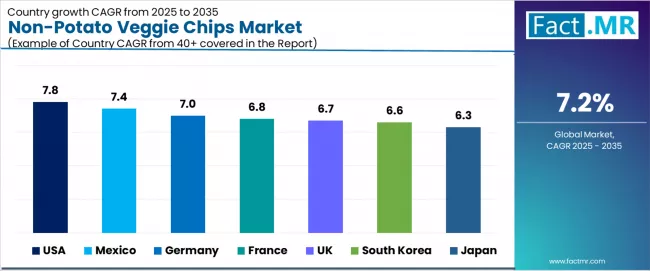
The market demonstrates varied regional dynamics with Growth Leaders including the United States (7.8% CAGR) and Mexico (7.4% CAGR) driving expansion through health food retail capacity additions and wellness development programs. Steady Performers encompass Germany (7.0% CAGR), France (6.8% CAGR), and United Kingdom (6.7% CAGR), benefiting from established health food industries and advanced wellness adoption. Mature Markets feature South Korea (6.6% CAGR) and Japan (6.3% CAGR), where specialized health applications and nutrition technology integration support consistent growth patterns.
| Country | CAGR (2025-2035) |
|---|---|
| United States | 7.8% |
| Mexico | 7.4% |
| Germany | 7.0% |
| France | 6.8% |
| United Kingdom | 6.7% |
| South Korea | 6.6% |
| Japan | 6.3% |
Regional synthesis reveals developed markets leading adoption through health consciousness expansion and wellness infrastructure development, while emerging countries maintain strong expansion supported by retail modernization and nutrition awareness requirements. North American and European markets show robust growth driven by health food applications and wellness technology integration trends.
United States Demonstrates Technology Innovation
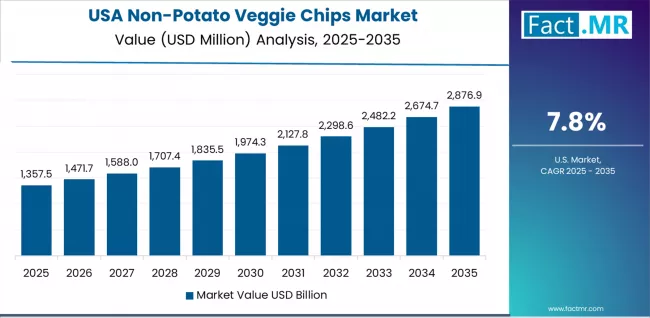
The U.S. market emphasizes advanced processing features, including precision nutrition control and integration with comprehensive retail platforms that manage product quality, distribution optimization, and consumer satisfaction applications through unified monitoring systems. The country demonstrates strong growth at 7.8% CAGR, driven by health food modernization, wellness expansion projects, and emerging functional nutrition applications that support veggie chip integration. American retailers prioritize operational effectiveness with non-potato veggie chips delivering consistent nutritional performance through advanced processing algorithms and retail adaptation capabilities.
Technology deployment channels include major health food retailers, specialized wellness suppliers, and retail procurement programs that support professional applications for complex health merchandising and nutritional applications. Retail platform integration capabilities with established health food systems expand market appeal across diverse consumer requirements seeking nutrition and taste benefits. The resilient health food sector and expanding wellness retail capacity additions create steady demand, while innovative applications in functional foods open new growth avenues.
Performance Metrics:
- Health food retail facilities in California, New York, and Texas leading adoption for wellness retail operations
- Health food distributor channels maintaining 71% market share for complex retail integration applications
- Wellness retail programs supporting 36% of product acquisitions across health food and specialty retail facilities
- Retail platform compatibility with major health food systems driving procurement selection criteria
Germany Maintains Technology Leadership
Germany's advanced health food market demonstrates sophisticated veggie chip deployment with documented operational effectiveness in retail applications and wellness facilities through integration with existing retail systems and distribution infrastructure. The country leverages engineering expertise in food processing and retail systems integration to maintain strong growth at 7.0% CAGR. Industrial centers, including Munich, Berlin, and Hamburg, showcase premium installations where processing systems integrate with comprehensive retail platforms and wellness management systems to optimize health food distribution and nutritional effectiveness.
German health food companies prioritize product reliability and EU compliance in processing development, creating demand for premium nutrition systems with advanced features, including quality monitoring integration and automated retail systems. The market benefits from established health food infrastructure and a willingness to invest in advanced nutrition technologies that provide long-term consumer benefits and compliance with international food safety and wellness standards. Premium health food applications, specialty processing systems, and wellness programs drive diversified demand across multiple end-use segments.
Market Intelligence Brief:
- Engineering focuses on EU standardization and food safety compliance, driving premium segment growth
- Health food partnerships providing 42% faster development cycles
- Technology collaboration between German health food companies and international wellness companies
- Retail training programs expanding veggie chip integration in health food and wellness scenarios
France Shows Balanced Wellness Growth
France maintains steady expansion at 6.8% CAGR through diversified demand from health food programs, retail modernization activities, and specialty nutrition development projects. Major wellness regions in Paris, Lyon, and Provence drive veggie chip adoption for commercial and artisanal health food production. Wellness research and development programs create constant nutrition demand, while gourmet health applications provide additional growth opportunities. Government support for nutrition innovation and food health initiatives supports consistent market development.
Market Characteristics:
- Advanced nutrition research capabilities and food regulations are creating demand for innovative processing technologies supporting sustainable health development and wellness optimization
- Strong culinary tradition and gourmet excellence leadership are driving the adoption of premium nutrition technologies and artisanal health materials throughout retail and specialty food facilities
United Kingdom Drives Health Food and Wellness Integration
The U.K. market holds steady growth at 6.7% CAGR, driven by health food modernization activities, wellness retail programs, and innovative nutrition adoption trends. British health food retailers and wellness companies are implementing advanced veggie chip systems to enhance distribution capabilities and support retail operations that align with food safety regulations and wellness standards. Market expansion benefits from government wellness programs that mandate nutritional capabilities in health food and retail specifications, creating steady demand where consumer satisfaction and food safety compliance represent critical requirements.
Strategic Market Indicators:
- Health food retail and wellness facilities leading adoption with modernization programs requiring advanced nutrition systems
- Government wellness programs providing regulatory support for advanced nutrition system acquisition
- Food safety compliance requirements driving demand for standardized systems with international operational compatibility
- Specialized organic food and sustainable wellness segments adopting comprehensive nutrition solutions for health optimization
Japan Prioritizes Precision and Nutrition Excellence
Japan demonstrates steady market development with a 6.3% CAGR, distinguished by health food and wellness producers' preference for high-quality veggie chip systems that integrate seamlessly with existing retail systems and provide reliable long-term operation in specialized nutrition applications. The market prioritizes advanced features, including precision nutrition control, food safety durability, and integration with comprehensive retail platforms that reflect Japanese industry expectations for technological sophistication and operational excellence.
High-specification health food and specialty nutrition applications drive demand, supported by advanced wellness research and development initiatives. Japanese operators prioritize nutrition precision, consistent performance characteristics, and comprehensive quality documentation that aligns with stringent health food standards. The focus on premium applications and technical excellence supports stable growth despite mature market conditions.
Market Characteristics:
- Premium focus on kale/spinach systems with advanced processing algorithms and precision nutrition capabilities
- Integration requirements with existing health food retail and wellness platforms
- Focus on operational reliability and long-term durability in health food and specialty applications
South Korea Emphasizes Advanced Nutrition Integration
South Korea demonstrates robust market development with a 6.6% CAGR, distinguished by health food and wellness producers' preference for high-quality veggie chip systems that integrate seamlessly with existing retail systems and provide reliable long-term operation in specialized nutrition applications. The market prioritizes advanced features, including precision nutrition control, food safety durability, and integration with comprehensive retail platforms that reflect Korean industry expectations for technological sophistication and operational excellence.
Growth drivers encompass wellness technology applications, expanding health food modernization requirements, and advanced nutrition system integration. Korean operators prioritize quality control systems and comprehensive technical support that align with domestic health food standards. The convergence of high-tech food processing, wellness innovation, and growing specialty nutrition production creates diversified demand across multiple application segments.
Market Characteristics:
- Premium focus on kale/spinach systems with advanced processing formulation algorithms and precision nutrition capabilities
- Integration requirements with existing health food retail and wellness platforms
- Focus on operational reliability and long-term durability in health food and wellness applications
Mexico Emerges as High-Growth Market
Mexico leads growth momentum with a 7.4% CAGR, driven by rapid wellness modernization, expanding health food applications, and nutrition development adoption across major urban regions including Mexico City, Guadalajara, and Monterrey. Health consciousness development and wellness retail requirements drive primary demand, while growing food manufacturing and export sectors create diversified application opportunities. Government nutrition initiatives and health food programs support steady expansion. The convergence of wellness modernization, health food standards improvement, and nutrition capacity expansion positions Mexico as a key emerging market for veggie chip products.
Strategic Market Indicators:
- Government support for health food development and wellness industry expansion is driving demand for specialty nutrition technologies throughout major urban regions and health food clusters across retail facilities, wellness centers, and nutrition manufacturing centers
- Strong health food sector growth and an expanding network of wellness retail facilities are supporting the rapid adoption of veggie chip technologies among retailers seeking enhanced nutrition efficiency and innovative health food offerings
Europe Market Split by Country
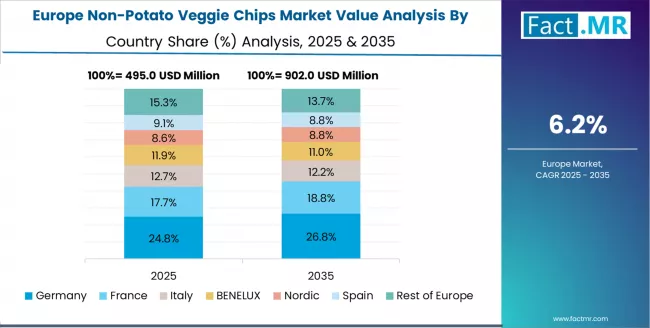
The European Non-Potato Veggie Chips market is projected to grow from USD 0.62 billion in 2025 to USD 1.25 billion by 2035, registering a CAGR of 7.3% over the forecast period. Germany is expected to maintain its leadership position with a 27.8% market share in 2025, declining slightly to 27.3% by 2035, supported by its advanced health food infrastructure and major wellness centers in Munich and Berlin.
France follows with a 19.4% share in 2025, projected to reach 19.7% by 2035, driven by comprehensive wellness modernization programs and gourmet health initiatives. The United Kingdom holds a 18.1% share in 2025, expected to moderate to 17.6% by 2035 through specialized health food activities and wellness applications. Italy commands a 13.2% share in 2025, rising to 13.5% by 2035 through strong wellness and nutrition projects. Spain accounts for 9.7% in 2025, reaching 9.9% by 2035 aided by health food modernization and wellness applications. The Netherlands maintains a 4.3% share in 2025, increasing to 4.4% by 2035 driven by specialty wellness and health innovation demand. The Rest of Europe region is anticipated to hold 7.5% in 2025, increasing to 7.6% by 2035, reflecting steady adoption in Nordic countries and Central & Eastern European wellness upgrades.
Kale/Spinach Dominates Nutrition Demand in Japan
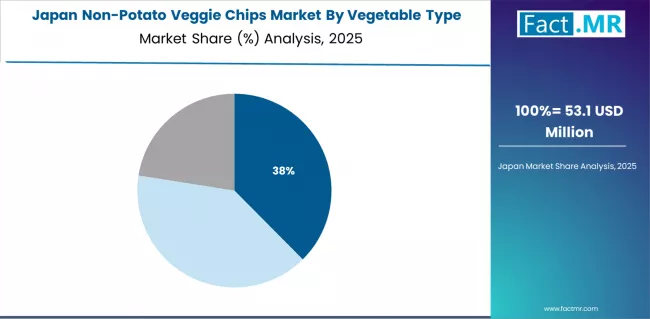
In Japan, the market prioritizes kale/spinach systems, which capture the dominant share of health food retail and specialty wellness installations due to their advanced features, including precision nutrition optimization and seamless integration with existing health food distribution infrastructure. Japanese health food retailers emphasize reliability, precision, and long-term nutritional excellence, creating demand for kale/spinach systems that provide consistent nutritional capabilities and adaptive health performance based on consumer requirements and wellness conditions. Beetroot chip systems maintain secondary positions primarily in specialized wellness applications and health food installations where comprehensive nutrition functionality meets consumer requirements without compromising taste satisfaction.
Strategic Market Indicators:
- Premium focus on kale/spinach systems with advanced processing formulation algorithms and precision nutrition capabilities
- Integration requirements with existing health food retail platforms and specialty wellness systems
- Focus on operational reliability and long-term durability in health food and wellness applications
Health Food Companies Lead Wellness Services in South Korea
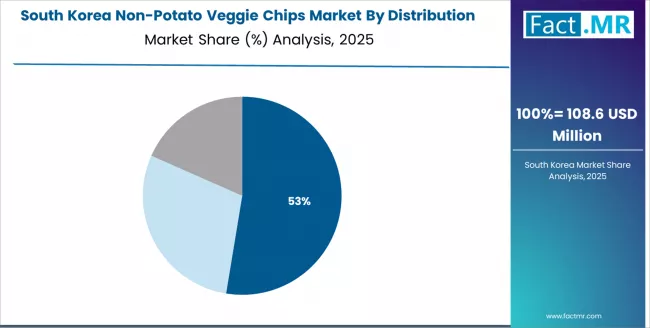
In South Korea, the market structure favors international health food companies, including Rhythm Foods, Bare Snacks, and General Mills, which maintain dominant positions through comprehensive product portfolios and established wellness retail networks supporting both health food stores and online nutrition installations. These providers offer integrated solutions combining advanced veggie chip systems with professional distribution services and ongoing consumer support that appeal to Korean retailers seeking reliable specialty wellness products. Local health food contractors and retail integrators capture a moderate market share by providing localized service capabilities and competitive pricing for standard health food installations, while domestic manufacturers focus on specialized applications and cost-effective solutions tailored to Korean wellness characteristics.
Channel Insights:
- International health food brands maintaining premium market positioning through advanced wellness offerings
- Local wellness retail networks expanding to support growing demand for professional nutrition and health services
- System integration capabilities becoming a key differentiator for facility-wide and health food retail nutrition applications
Competitive Landscape of the Non-Potato Veggie Chips Market
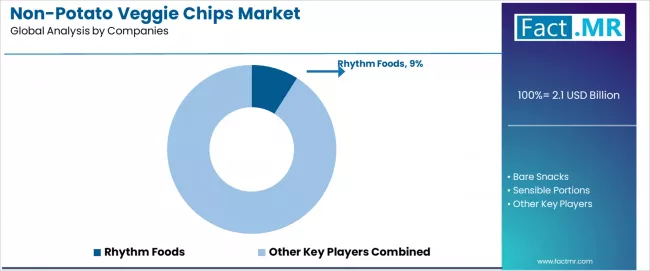
The market operates with moderate concentration, featuring approximately 12-15 meaningful participants, where leading companies control roughly 42-47% of the global market share through established health food relationships and comprehensive nutrition portfolios. Competition emphasizes advanced processing capabilities, product reliability, and retail integration rather than price-based rivalry. The leading company, Rhythm Foods, commands approximately 9.0% market share through its specialized veggie chip portfolio and extensive health food retail and wellness industry presence.
Market Leaders encompass Rhythm Foods, Bare Snacks, and Sensible Portions, which maintain competitive advantages through extensive health food processing expertise, global wellness retail contractor networks, and comprehensive distribution integration capabilities that create customer switching costs and support premium pricing. These companies leverage years of nutrition technology experience and ongoing research investments to develop advanced veggie chip systems with precision nutrition control and retail monitoring features.
Technology Innovators include Brad's Plant Based, Simply 7, and General Mills, which compete through specialized processing technology focus and innovative health applications that appeal to consumers seeking advanced nutritional capabilities and taste satisfaction. These companies differentiate through rapid product development cycles and specialized health food and wellness application focus.
Regional Specialists feature companies like PepsiCo, Hain Celestial, Calbee, and Beanitos, which focus on specific geographic markets and specialized applications, including veggie chip-based systems and integrated retail solutions. Market dynamics favor participants that combine reliable nutrition capabilities with advanced retail software, including precision health control and automatic performance optimization capabilities. Competitive pressure intensifies as traditional snack food contractors expand into veggie chip systems, while specialized health companies challenge established players through innovative nutrition solutions and cost-effective platforms targeting specialized wellness and retail segments.
Key Players in the Non-Potato Veggie Chips Market
- Rhythm Foods
- Bare Snacks
- Sensible Portions
- Brad's Plant Based
- Simply 7
- General Mills
- PepsiCo
- Hain Celestial
- Calbee
- Beanitos
Scope of the Report
| Item | Value |
|---|---|
| Quantitative Units | USD 2.1 billion |
| Vegetable Type | Kale/spinach, Beetroot, Carrot/others |
| Distribution Channel | Retail, Online, Foodservice |
| Claim | Organic/Natural, Gluten-free, Conventional |
| Regions Covered | North America, Europe, Asia Pacific, Latin America, Middle East & Africa |
| Countries Covered | United States, Germany, France, United Kingdom, Japan, South Korea, Mexico, and 18+ additional countries |
| Key Companies Profiled | Rhythm Foods, Bare Snacks, Sensible Portions, Brad's Plant Based, Simply 7, General Mills, PepsiCo |
| Additional Attributes | Dollar sales by vegetable type and distribution categories, regional adoption trends across North America, Europe, and Asia Pacific, competitive landscape with health food manufacturers and wellness retail suppliers, consumer preferences for nutritional content and taste satisfaction, integration with retail platforms and health food quality monitoring systems, innovations in kale/spinach-based processing and organic compliance, and development of automated processing solutions with enhanced performance and retail optimization capabilities. |
Non-Potato Veggie Chips Market by Segments
-
Vegetable Type :
- Kale/spinach
- Beetroot
- Carrot/others
-
Distribution Channel :
- Retail
- Online
- Foodservice
-
Claim :
- Organic/Natural
- Gluten-free
- Conventional
-
Region :
- North America
- United States
- Canada
- Mexico
- Europe
- Germany
- France
- United Kingdom
- Italy
- Spain
- Netherlands
- Nordic
- Rest of Europe
- Asia Pacific
- Japan
- South Korea
- China
- India
- ASEAN
- Australia & New Zealand
- Rest of Asia Pacific
- Latin America
- Brazil
- Argentina
- Rest of Latin America
- Middle East & Africa
- GCC Countries
- South Africa
- Rest of Middle East & Africa
- North America
Table of Content
- Executive Summary
- Global Market Outlook
- Demand to side Trends
- Supply to side Trends
- Technology Roadmap Analysis
- Analysis and Recommendations
- Market Overview
- Market Coverage / Taxonomy
- Market Definition / Scope / Limitations
- Market Background
- Market Dynamics
- Drivers
- Restraints
- Opportunity
- Trends
- Scenario Forecast
- Demand in Optimistic Scenario
- Demand in Likely Scenario
- Demand in Conservative Scenario
- Opportunity Map Analysis
- Product Life Cycle Analysis
- Supply Chain Analysis
- Investment Feasibility Matrix
- Value Chain Analysis
- PESTLE and Porter’s Analysis
- Regulatory Landscape
- Regional Parent Market Outlook
- Production and Consumption Statistics
- Import and Export Statistics
- Market Dynamics
- Global Market Analysis 2020 to 2024 and Forecast, 2025 to 2035
- Historical Market Size Value (USD Million) Analysis, 2020 to 2024
- Current and Future Market Size Value (USD Million) Projections, 2025 to 2035
- Y to o to Y Growth Trend Analysis
- Absolute $ Opportunity Analysis
- Global Market Pricing Analysis 2020 to 2024 and Forecast 2025 to 2035
- Global Market Analysis 2020 to 2024 and Forecast 2025 to 2035, By Vegetable Type
- Introduction / Key Findings
- Historical Market Size Value (USD Million) Analysis By Vegetable Type , 2020 to 2024
- Current and Future Market Size Value (USD Million) Analysis and Forecast By Vegetable Type , 2025 to 2035
- Kale/spinach
- Beetroot
- Carrot/others
- Y to o to Y Growth Trend Analysis By Vegetable Type , 2020 to 2024
- Absolute $ Opportunity Analysis By Vegetable Type , 2025 to 2035
- Global Market Analysis 2020 to 2024 and Forecast 2025 to 2035, By Distribution Channel
- Introduction / Key Findings
- Historical Market Size Value (USD Million) Analysis By Distribution Channel, 2020 to 2024
- Current and Future Market Size Value (USD Million) Analysis and Forecast By Distribution Channel, 2025 to 2035
- Retail
- Online
- Foodservice
- Y to o to Y Growth Trend Analysis By Distribution Channel, 2020 to 2024
- Absolute $ Opportunity Analysis By Distribution Channel, 2025 to 2035
- Global Market Analysis 2020 to 2024 and Forecast 2025 to 2035, By Region
- Introduction
- Historical Market Size Value (USD Million) Analysis By Region, 2020 to 2024
- Current Market Size Value (USD Million) Analysis and Forecast By Region, 2025 to 2035
- North America
- Latin America
- Western Europe
- Eastern Europe
- East Asia
- South Asia and Pacific
- Middle East & Africa
- Market Attractiveness Analysis By Region
- North America Market Analysis 2020 to 2024 and Forecast 2025 to 2035, By Country
- Historical Market Size Value (USD Million) Trend Analysis By Market Taxonomy, 2020 to 2024
- Market Size Value (USD Million) Forecast By Market Taxonomy, 2025 to 2035
- By Country
- USA
- Canada
- Mexico
- By Vegetable Type
- By Distribution Channel
- By Country
- Market Attractiveness Analysis
- By Country
- By Vegetable Type
- By Distribution Channel
- Key Takeaways
- Latin America Market Analysis 2020 to 2024 and Forecast 2025 to 2035, By Country
- Historical Market Size Value (USD Million) Trend Analysis By Market Taxonomy, 2020 to 2024
- Market Size Value (USD Million) Forecast By Market Taxonomy, 2025 to 2035
- By Country
- Brazil
- Chile
- Rest of Latin America
- By Vegetable Type
- By Distribution Channel
- By Country
- Market Attractiveness Analysis
- By Country
- By Vegetable Type
- By Distribution Channel
- Key Takeaways
- Western Europe Market Analysis 2020 to 2024 and Forecast 2025 to 2035, By Country
- Historical Market Size Value (USD Million) Trend Analysis By Market Taxonomy, 2020 to 2024
- Market Size Value (USD Million) Forecast By Market Taxonomy, 2025 to 2035
- By Country
- Germany
- UK
- Italy
- Spain
- France
- Nordic
- BENELUX
- Rest of Western Europe
- By Vegetable Type
- By Distribution Channel
- By Country
- Market Attractiveness Analysis
- By Country
- By Vegetable Type
- By Distribution Channel
- Key Takeaways
- Eastern Europe Market Analysis 2020 to 2024 and Forecast 2025 to 2035, By Country
- Historical Market Size Value (USD Million) Trend Analysis By Market Taxonomy, 2020 to 2024
- Market Size Value (USD Million) Forecast By Market Taxonomy, 2025 to 2035
- By Country
- Russia
- Poland
- Hungary
- Balkan & Baltic
- Rest of Eastern Europe
- By Vegetable Type
- By Distribution Channel
- By Country
- Market Attractiveness Analysis
- By Country
- By Vegetable Type
- By Distribution Channel
- Key Takeaways
- East Asia Market Analysis 2020 to 2024 and Forecast 2025 to 2035, By Country
- Historical Market Size Value (USD Million) Trend Analysis By Market Taxonomy, 2020 to 2024
- Market Size Value (USD Million) Forecast By Market Taxonomy, 2025 to 2035
- By Country
- China
- Japan
- South Korea
- By Vegetable Type
- By Distribution Channel
- By Country
- Market Attractiveness Analysis
- By Country
- By Vegetable Type
- By Distribution Channel
- Key Takeaways
- South Asia and Pacific Market Analysis 2020 to 2024 and Forecast 2025 to 2035, By Country
- Historical Market Size Value (USD Million) Trend Analysis By Market Taxonomy, 2020 to 2024
- Market Size Value (USD Million) Forecast By Market Taxonomy, 2025 to 2035
- By Country
- India
- ASEAN
- Australia & New Zealand
- Rest of South Asia and Pacific
- By Vegetable Type
- By Distribution Channel
- By Country
- Market Attractiveness Analysis
- By Country
- By Vegetable Type
- By Distribution Channel
- Key Takeaways
- Middle East & Africa Market Analysis 2020 to 2024 and Forecast 2025 to 2035, By Country
- Historical Market Size Value (USD Million) Trend Analysis By Market Taxonomy, 2020 to 2024
- Market Size Value (USD Million) Forecast By Market Taxonomy, 2025 to 2035
- By Country
- Kingdom of Saudi Arabia
- Other GCC Countries
- Turkiye
- South Africa
- Other African Union
- Rest of Middle East & Africa
- By Vegetable Type
- By Distribution Channel
- By Country
- Market Attractiveness Analysis
- By Country
- By Vegetable Type
- By Distribution Channel
- Key Takeaways
- Key Countries Market Analysis
- USA
- Pricing Analysis
- Market Share Analysis, 2024
- By Vegetable Type
- By Distribution Channel
- Canada
- Pricing Analysis
- Market Share Analysis, 2024
- By Vegetable Type
- By Distribution Channel
- Mexico
- Pricing Analysis
- Market Share Analysis, 2024
- By Vegetable Type
- By Distribution Channel
- Brazil
- Pricing Analysis
- Market Share Analysis, 2024
- By Vegetable Type
- By Distribution Channel
- Chile
- Pricing Analysis
- Market Share Analysis, 2024
- By Vegetable Type
- By Distribution Channel
- Germany
- Pricing Analysis
- Market Share Analysis, 2024
- By Vegetable Type
- By Distribution Channel
- UK
- Pricing Analysis
- Market Share Analysis, 2024
- By Vegetable Type
- By Distribution Channel
- Italy
- Pricing Analysis
- Market Share Analysis, 2024
- By Vegetable Type
- By Distribution Channel
- Spain
- Pricing Analysis
- Market Share Analysis, 2024
- By Vegetable Type
- By Distribution Channel
- France
- Pricing Analysis
- Market Share Analysis, 2024
- By Vegetable Type
- By Distribution Channel
- India
- Pricing Analysis
- Market Share Analysis, 2024
- By Vegetable Type
- By Distribution Channel
- ASEAN
- Pricing Analysis
- Market Share Analysis, 2024
- By Vegetable Type
- By Distribution Channel
- Australia & New Zealand
- Pricing Analysis
- Market Share Analysis, 2024
- By Vegetable Type
- By Distribution Channel
- China
- Pricing Analysis
- Market Share Analysis, 2024
- By Vegetable Type
- By Distribution Channel
- Japan
- Pricing Analysis
- Market Share Analysis, 2024
- By Vegetable Type
- By Distribution Channel
- South Korea
- Pricing Analysis
- Market Share Analysis, 2024
- By Vegetable Type
- By Distribution Channel
- Russia
- Pricing Analysis
- Market Share Analysis, 2024
- By Vegetable Type
- By Distribution Channel
- Poland
- Pricing Analysis
- Market Share Analysis, 2024
- By Vegetable Type
- By Distribution Channel
- Hungary
- Pricing Analysis
- Market Share Analysis, 2024
- By Vegetable Type
- By Distribution Channel
- Kingdom of Saudi Arabia
- Pricing Analysis
- Market Share Analysis, 2024
- By Vegetable Type
- By Distribution Channel
- Turkiye
- Pricing Analysis
- Market Share Analysis, 2024
- By Vegetable Type
- By Distribution Channel
- South Africa
- Pricing Analysis
- Market Share Analysis, 2024
- By Vegetable Type
- By Distribution Channel
- USA
- Market Structure Analysis
- Competition Dashboard
- Competition Benchmarking
- Market Share Analysis of Top Players
- By Regional
- By Vegetable Type
- By Distribution Channel
- Competition Analysis
- Competition Deep Dive
- Rhythm Foods
- Overview
- Product Portfolio
- Profitability by Market Segments (Product/Age /Sales Channel/Region)
- Sales Footprint
- Strategy Overview
- Marketing Strategy
- Product Strategy
- Channel Strategy
- Bare Snacks
- Sensible Portions
- Brad's Plant Based
- Simply 7
- General Mills
- PepsiCo
- Hain Celestial
- Calbee
- Beanitos
- Rhythm Foods
- Competition Deep Dive
- Assumptions & Acronyms Used
- Research Methodology
List Of Table
- Table 1: Global Market Value (USD Million) Forecast by Region, 2020 to 2035
- Table 2: Global Market Value (USD Million) Forecast by Vegetable Type , 2020 to 2035
- Table 3: Global Market Value (USD Million) Forecast by Distribution Channel, 2020 to 2035
- Table 4: North America Market Value (USD Million) Forecast by Country, 2020 to 2035
- Table 5: North America Market Value (USD Million) Forecast by Vegetable Type , 2020 to 2035
- Table 6: North America Market Value (USD Million) Forecast by Distribution Channel, 2020 to 2035
- Table 7: Latin America Market Value (USD Million) Forecast by Country, 2020 to 2035
- Table 8: Latin America Market Value (USD Million) Forecast by Vegetable Type , 2020 to 2035
- Table 9: Latin America Market Value (USD Million) Forecast by Distribution Channel, 2020 to 2035
- Table 10: Western Europe Market Value (USD Million) Forecast by Country, 2020 to 2035
- Table 11: Western Europe Market Value (USD Million) Forecast by Vegetable Type , 2020 to 2035
- Table 12: Western Europe Market Value (USD Million) Forecast by Distribution Channel, 2020 to 2035
- Table 13: Eastern Europe Market Value (USD Million) Forecast by Country, 2020 to 2035
- Table 14: Eastern Europe Market Value (USD Million) Forecast by Vegetable Type , 2020 to 2035
- Table 15: Eastern Europe Market Value (USD Million) Forecast by Distribution Channel, 2020 to 2035
- Table 16: East Asia Market Value (USD Million) Forecast by Country, 2020 to 2035
- Table 17: East Asia Market Value (USD Million) Forecast by Vegetable Type , 2020 to 2035
- Table 18: East Asia Market Value (USD Million) Forecast by Distribution Channel, 2020 to 2035
- Table 19: South Asia and Pacific Market Value (USD Million) Forecast by Country, 2020 to 2035
- Table 20: South Asia and Pacific Market Value (USD Million) Forecast by Vegetable Type , 2020 to 2035
- Table 21: South Asia and Pacific Market Value (USD Million) Forecast by Distribution Channel, 2020 to 2035
- Table 22: Middle East & Africa Market Value (USD Million) Forecast by Country, 2020 to 2035
- Table 23: Middle East & Africa Market Value (USD Million) Forecast by Vegetable Type , 2020 to 2035
- Table 24: Middle East & Africa Market Value (USD Million) Forecast by Distribution Channel, 2020 to 2035
List Of Figures
- Figure 1: Global Market Pricing Analysis
- Figure 2: Global Market Value (USD Million) Forecast 2020-2035
- Figure 3: Global Market Value Share and BPS Analysis by Vegetable Type , 2025 and 2035
- Figure 4: Global Market Y to o to Y Growth Comparison by Vegetable Type , 2025-2035
- Figure 5: Global Market Attractiveness Analysis by Vegetable Type
- Figure 6: Global Market Value Share and BPS Analysis by Distribution Channel, 2025 and 2035
- Figure 7: Global Market Y to o to Y Growth Comparison by Distribution Channel, 2025-2035
- Figure 8: Global Market Attractiveness Analysis by Distribution Channel
- Figure 9: Global Market Value (USD Million) Share and BPS Analysis by Region, 2025 and 2035
- Figure 10: Global Market Y to o to Y Growth Comparison by Region, 2025-2035
- Figure 11: Global Market Attractiveness Analysis by Region
- Figure 12: North America Market Incremental Dollar Opportunity, 2025-2035
- Figure 13: Latin America Market Incremental Dollar Opportunity, 2025-2035
- Figure 14: Western Europe Market Incremental Dollar Opportunity, 2025-2035
- Figure 15: Eastern Europe Market Incremental Dollar Opportunity, 2025-2035
- Figure 16: East Asia Market Incremental Dollar Opportunity, 2025-2035
- Figure 17: South Asia and Pacific Market Incremental Dollar Opportunity, 2025-2035
- Figure 18: Middle East & Africa Market Incremental Dollar Opportunity, 2025-2035
- Figure 19: North America Market Value Share and BPS Analysis by Country, 2025 and 2035
- Figure 20: North America Market Value Share and BPS Analysis by Vegetable Type , 2025 and 2035
- Figure 21: North America Market Y to o to Y Growth Comparison by Vegetable Type , 2025-2035
- Figure 22: North America Market Attractiveness Analysis by Vegetable Type
- Figure 23: North America Market Value Share and BPS Analysis by Distribution Channel, 2025 and 2035
- Figure 24: North America Market Y to o to Y Growth Comparison by Distribution Channel, 2025-2035
- Figure 25: North America Market Attractiveness Analysis by Distribution Channel
- Figure 26: Latin America Market Value Share and BPS Analysis by Country, 2025 and 2035
- Figure 27: Latin America Market Value Share and BPS Analysis by Vegetable Type , 2025 and 2035
- Figure 28: Latin America Market Y to o to Y Growth Comparison by Vegetable Type , 2025-2035
- Figure 29: Latin America Market Attractiveness Analysis by Vegetable Type
- Figure 30: Latin America Market Value Share and BPS Analysis by Distribution Channel, 2025 and 2035
- Figure 31: Latin America Market Y to o to Y Growth Comparison by Distribution Channel, 2025-2035
- Figure 32: Latin America Market Attractiveness Analysis by Distribution Channel
- Figure 33: Western Europe Market Value Share and BPS Analysis by Country, 2025 and 2035
- Figure 34: Western Europe Market Value Share and BPS Analysis by Vegetable Type , 2025 and 2035
- Figure 35: Western Europe Market Y to o to Y Growth Comparison by Vegetable Type , 2025-2035
- Figure 36: Western Europe Market Attractiveness Analysis by Vegetable Type
- Figure 37: Western Europe Market Value Share and BPS Analysis by Distribution Channel, 2025 and 2035
- Figure 38: Western Europe Market Y to o to Y Growth Comparison by Distribution Channel, 2025-2035
- Figure 39: Western Europe Market Attractiveness Analysis by Distribution Channel
- Figure 40: Eastern Europe Market Value Share and BPS Analysis by Country, 2025 and 2035
- Figure 41: Eastern Europe Market Value Share and BPS Analysis by Vegetable Type , 2025 and 2035
- Figure 42: Eastern Europe Market Y to o to Y Growth Comparison by Vegetable Type , 2025-2035
- Figure 43: Eastern Europe Market Attractiveness Analysis by Vegetable Type
- Figure 44: Eastern Europe Market Value Share and BPS Analysis by Distribution Channel, 2025 and 2035
- Figure 45: Eastern Europe Market Y to o to Y Growth Comparison by Distribution Channel, 2025-2035
- Figure 46: Eastern Europe Market Attractiveness Analysis by Distribution Channel
- Figure 47: East Asia Market Value Share and BPS Analysis by Country, 2025 and 2035
- Figure 48: East Asia Market Value Share and BPS Analysis by Vegetable Type , 2025 and 2035
- Figure 49: East Asia Market Y to o to Y Growth Comparison by Vegetable Type , 2025-2035
- Figure 50: East Asia Market Attractiveness Analysis by Vegetable Type
- Figure 51: East Asia Market Value Share and BPS Analysis by Distribution Channel, 2025 and 2035
- Figure 52: East Asia Market Y to o to Y Growth Comparison by Distribution Channel, 2025-2035
- Figure 53: East Asia Market Attractiveness Analysis by Distribution Channel
- Figure 54: South Asia and Pacific Market Value Share and BPS Analysis by Country, 2025 and 2035
- Figure 55: South Asia and Pacific Market Value Share and BPS Analysis by Vegetable Type , 2025 and 2035
- Figure 56: South Asia and Pacific Market Y to o to Y Growth Comparison by Vegetable Type , 2025-2035
- Figure 57: South Asia and Pacific Market Attractiveness Analysis by Vegetable Type
- Figure 58: South Asia and Pacific Market Value Share and BPS Analysis by Distribution Channel, 2025 and 2035
- Figure 59: South Asia and Pacific Market Y to o to Y Growth Comparison by Distribution Channel, 2025-2035
- Figure 60: South Asia and Pacific Market Attractiveness Analysis by Distribution Channel
- Figure 61: Middle East & Africa Market Value Share and BPS Analysis by Country, 2025 and 2035
- Figure 62: Middle East & Africa Market Value Share and BPS Analysis by Vegetable Type , 2025 and 2035
- Figure 63: Middle East & Africa Market Y to o to Y Growth Comparison by Vegetable Type , 2025-2035
- Figure 64: Middle East & Africa Market Attractiveness Analysis by Vegetable Type
- Figure 65: Middle East & Africa Market Value Share and BPS Analysis by Distribution Channel, 2025 and 2035
- Figure 66: Middle East & Africa Market Y to o to Y Growth Comparison by Distribution Channel, 2025-2035
- Figure 67: Middle East & Africa Market Attractiveness Analysis by Distribution Channel
- Figure 68: Global Market - Tier Structure Analysis
- Figure 69: Global Market - Company Share Analysis
- FAQs -
How big is the non-potato veggie chips market in 2025?
The global non-potato veggie chips market is estimated to be valued at USD 2.1 billion in 2025.
What will be the size of non-potato veggie chips market in 2035?
The market size for the non-potato veggie chips market is projected to reach USD 4.2 billion by 2035.
How much will be the non-potato veggie chips market growth between 2025 and 2035?
The non-potato veggie chips market is expected to grow at a 7.2% CAGR between 2025 and 2035.
What are the key product types in the non-potato veggie chips market?
The key product types in non-potato veggie chips market are kale/spinach, beetroot and carrot/others.
Which distribution channel segment to contribute significant share in the non-potato veggie chips market in 2025?
In terms of distribution channel, retail segment to command 54.0% share in the non-potato veggie chips market in 2025.